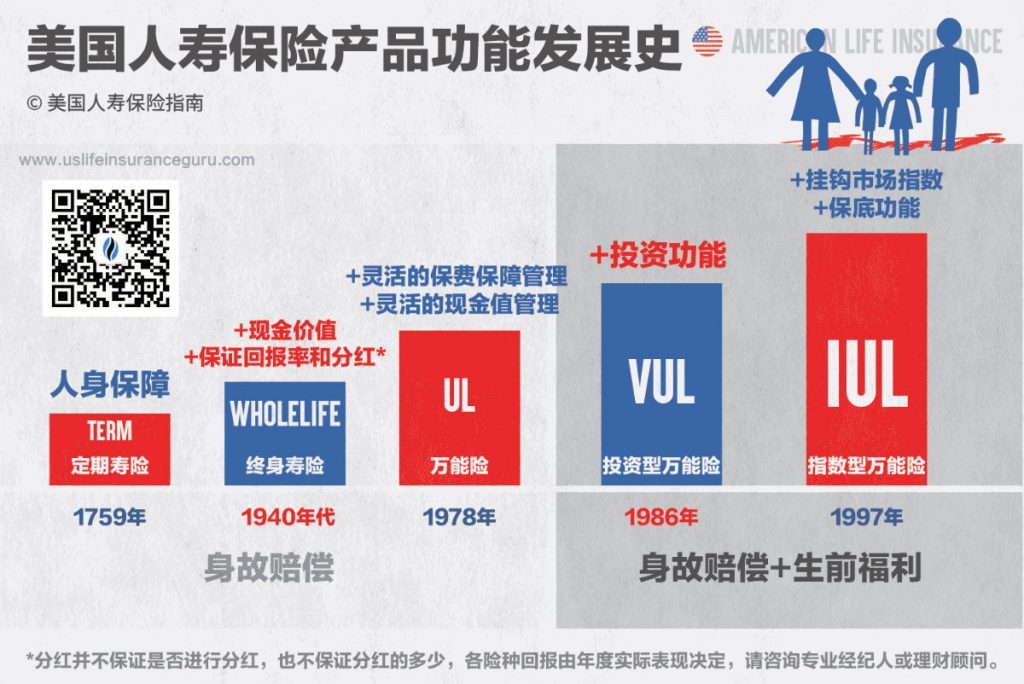美国人寿保险指南编者注:用人寿保单藏钱,能藏多少钱,并能免税提取的历史,是政府,保险公司,市场这三者相互影响,竞争和进步的历史故事。
 正文
正文
在20世纪80年代初期,万能险UL产品横空出世,提供了支付保费“灵活性”的巨大进步,革了储蓄分红型保险 Whole Life “铁板一块”的命。当时,由于相关法律和税务条例尚未跟上,于是,很多投保人发现,他们可以大量往保单里面放钱,同时只买极小的身故赔偿面额,然后收益完全免税!
这样的好消息禁不住一传十,十传百的传播。很快,这类本来是用来进行身故赔偿的人寿保险产品,完完全全变成了一个“免税”的投资品。
到了1982年,国会开始关注这个问题,并通过了TEFRA法案(Tax Equity and Fiscal Responsibility Acts of 1982,又名税收公平和财政责任法案)。该法律规定,所有可以灵活支付保费的保单,必须是合格的人寿保险,才能享受现金值积累和延税。总之一句话,就是,不准投机了!
根据TEFRA,验证保单是否是合格人寿保险产品的标准有两条,一是退保价值不能超过净单比保费金额;二是身故赔偿金必须体现和现金值有一定比例关系。
1984年的GPT和CVAT
两年后,1984年的赤字削减法案(Deficit Reduction Act,简称DEFRA)明确规定了人寿保险的法定定义。 DEFRA适用于所有具有现金价值的人寿保险保单,而不仅仅是具备“灵活性保费“的保单产品。从 1984年以后,在美国签发的人寿保险合同,只有满足以下两项检验中的一项(或两项)的要求,才有资格被当作人寿保险合同对待:
Guideline Premium Test
- Guideline Premium Test,简称GPT,包含了两项测试:Guideline Single Premium(GSP) 和 Guideline Annual Premium(GAP) 。测试规定了一张保单里终身最多能存多少钱。具体来说,就是投保人存入的总金额,不能超过GSP,或者逐年累计的GAP。
- Cash Value Accumulation Test,简称CVAT,要求一份保单里,当累计的现金值太多,保险公司的风险随之增大时,那么身故赔偿金需要对应上调。
如果一份保单无法满足TEFRA 或 DEFRA 的测试标准,那么这份合约就不会被认为是人寿保险保单合约。那么这份合同里面的现金值利滚利的收益,将会当作每年收入一样纳税。
7-Pay Test的引入
游戏就这么结束了?当然不是。
在当时,从人寿保险保单中取钱,是基于“先进先出”的原则。它的意思是,支付的保费先被支取出来,因为这部分保费是用税后的钱交付的,所以取出的时候,是免税的。同理,向保单借贷也是免税的,除非投保人放弃保单,这种情况另算。
于是,一部分人寿保险公司,非常激进地推广 可以存入大笔现金的保单,最著名的,就是一类储蓄分红型终身寿险产品:Single-Premium Whole Life。这类产品属于合规人寿保险产品,但是却更像一个低风险的投资品。
这类保单借贷的成本很低,甚至有时候完全没成本。投保人可以通过不断“借”的方式从保单里拿到收益部分,而不用交税。当投保人身故以后,这份保单先偿还这个欠款,剩下的部分支付给受益人,同样,整个过程也不产生任何税费(IRC Code.101)。
显然,这类储蓄分红型终身寿险产品(Single-Premium Whole Life)就开始了热卖。
政府很快发现,从富人手上又收不到税了。国会开始认定这种方式不合适,因为它与其他投资的待遇比起来,显得不公平,而且损害了公共税收。于是,政府很快修订推出了US Code 7702 条款,严格规定人寿保险的定义,并引入7-Pay 测试,划分出一条能放入多少钱的清晰界限。简单的说,就是保单存入的钱,没有通过7-pay测试的话,不再认定是人寿保单,不给予税收优惠,一律算作投资品交税。
7-Pay 测试
- 7-Pay测试用来确认一份合同是否属于合格的人寿保险保单。
- 7-Pay 指出了每年能最大放入的保费金额数字。
美国人寿保险指南网的范例
老张,45岁,不吸烟,希望投保100万,在不违反 7 年测试的情况下,往保单里存10年钱,在10年后为孩子支付未来的教育费用。
我们假设老张的保险成本最大值情况是,每1000美金保额,对应最大成本$31.008 ,保额是$1,000,000,假定根据7-pay Test计算结果,第一年的最大能存入的保费是:$31,008。

老张根据自己的经济实力,打算每年往保单存入$20,000,从上图看出,老张连续4年往保单里存了2万美金,在4年后,老张累积向保单支付了8万美金,小于了7-Pay测试规定的,第4年$124,032美元的上限。
老张在第5年决定继续多存钱,每年存入$50,000美金,这在第5年和第6年没有问题。如上图所示,到了第7年,老张为了保住这张人寿保险保单,最多就只能放入$37,056美金,因为这时候。累积存入的保费是$217,056,达到了7-pay 测试在第7年的上限值:$217,056。
如美国人寿保险指南网绘制的这张表格所示,老张的付费方式和金额,保证了老张的保单从来没有超过规定的金额,因此可以通过这个测试。这张保单因此也一直可以被当作人寿保险保单对待,里面的钱享受税收优惠。
总结
政府为了维护自己的利益,防止人们把钱藏在人寿保险账户里来避税和赚取免税的收益,特别是针对早期一次付清的人寿保险产品,可以说是下了大力气。但是,人寿金融类保险公司作为社会或商业机构,也分担了政府的一部分社会责任,政府也需要给予人寿金融类保险公司一定的利益让渡。
同时,由于市场之间的竞争,金融保险公司也在不断的创新,不断推出新的产品,走在现有政策和制度前面。政府,公司以及市场这三者之间的动态平衡环境,在美国孕育创造了理念远远领先于其他国家和地区、同时又极具市场竞争力的人寿保险金融产品。
美国市场上有不少的可以灵活支付保费的人寿保险产品,通过专业的理财顾问或经纪人的选品和产品方案设计,不光可以大量存入现金值,也能不违反7-Pay测试原则。最重要的是,即使已经存入了最大额度的保费金额,仍可以按照保费“先进先出”的方式,从保单中大笔提款。



